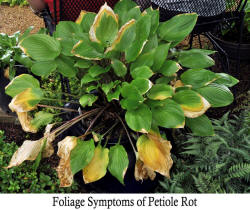Southern blight of
hosta
also called white mold, petiole roty and crown rot is caused by the
fungus Sclerotium rolfsii. In addition to hosta
it is also an infection daylily,
astilbe, peony,
phlox,
ajuga, delphinium and potato.
 The disease commonly
attacks the plant at or just below the soil line. The
first symptom is a yellowing and wilting of the foliage.
The fungus produces a large amount of cottony white,
thread like material called mycelium, which can grow up
the stems of plants and also spread out across the soil
to infect other plants.
The disease commonly
attacks the plant at or just below the soil line. The
first symptom is a yellowing and wilting of the foliage.
The fungus produces a large amount of cottony white,
thread like material called mycelium, which can grow up
the stems of plants and also spread out across the soil
to infect other plants.
Although this is called
Southern blight, it does occur in northern gardens too
but is fairly uncommon. It is a difficult disease to
control and, for the home hosta gardener, the key is
sanitation. If you have this disease (diagnosed by a
reputable plant lab), be especially careful in moving
plants around the garden and transporting soil from one
location to another on tools.
In Southern states, the
process of solarization my kill the fungus in the soil.
This involves covering the area with clear plastic
sheets and letting the sun "cook" the soil.
Unfortunately, this does not seem to work as well in
northern areas.
If you have a serious
problem that cannot be controlled by sanitation or
solarization, you might need to hire a commercial
pesticide applicator. Only they have access to the
soil sterilants that are supposed to be effective on this
disease. They are not available to the home grower.
Here is a great
publication by
Iowa State University on this subject.



